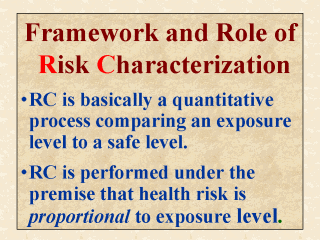| front |1 |2 |3 |4 |5 |6 |7 |8 |9 |10 |11 |12 |13 |14 |15 |16 |17 |18 |19 |20 |21 |22 |23 |24 |25 |26 |27 |review |
 |
As discussed in
the last slide, health risk assessment (RA) can be defined either as a public health
discipline, or straightly as a quantitative process wherein the risk is assessed and later
characterized. Yet throughout this lecture, RA pretty much takes on the latter
connotation in an effort to lead to a fuller treatment of health risk characterization
(RC). In its simplest term, RA as well as RC is a quantitative process comparing an
estimated exposure level to a level pre-established as safe or insignificant. The risk
involved is assumed to be proportionally greater if the In Lecture 3, references were given for several regulatory guidelines on the proper conducting of acute and long-term animal toxicity studies. The art and science of identifying and assessing hazards from exposure to environmental contaminants are not readily reflected in those guidelines or in earlier lectures. For completeness, they are thus discussed in the next two slides. |